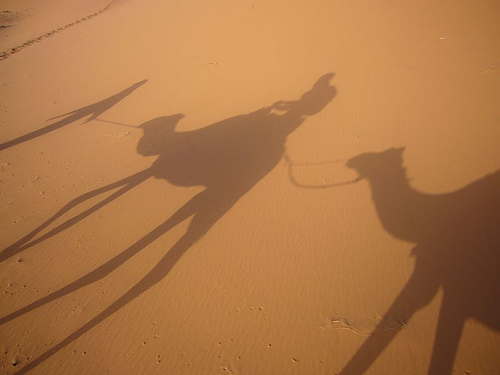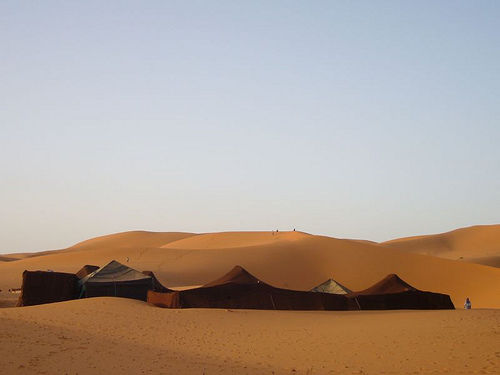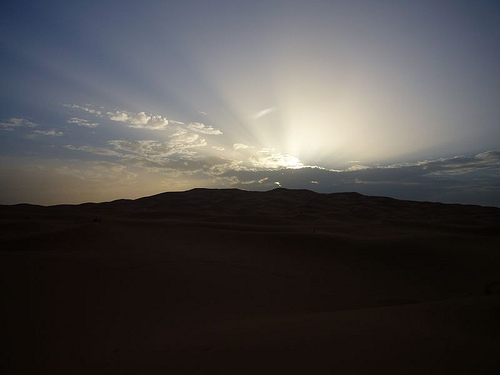Fur is tickling my calves and the wobbling movements are making me slightly sea sick. It feels like I just stepped on board a small boat, but instead of water, all I can see are the impressive velvet dunes of Erg Chebbi spreading before me like a gigantic blanket. An erg (meaning sand sea or dune sea) is a large, relatively flat area of desert covered with wind-swept sand with little to no vegetation cover. The dunes of Erg Chebbi, some of which reach a stunning height of 150 meters, are located about 40 kilometers from Erfoud, Morocco.
As I am trying to keep my balance my “ship of the desert”, a friendly dromedary camel, is moving slowly but steadily, his broad leathery footpads are keeping us from sinking into the soft sand. A young barefoot Berber boy (indigenous people of North Africa) covered in an indigo robe leads the way. I envy the ease with which he walks up and down the dunes while I am trying to find a comfortable position on my dromedary, almost impossible.
Wonders of nature


Dromedaries are, unlike me, amazingly well adapted to the hard life in the desert. Where I need a scarf and sunglasses to prevent the wind from sweeping the fine sand in my eyes, they have beautiful long thick eyelashes to protect them. They can carry heavy loads and can go up to four or fives days without drinking water. A dromedary has all kinds of “tricks” not to lose this precious liquid: they do not sweat until their body temperature reaches 42ºC, their blood cells are elastic enough to hold lots of water and they have a divided upper lip and grooved nostrils which channel moisture back into the mouth. Those are only a few of the tricks this animal has up his sleeve! By the way, dromedaries do not store water in their hump, as many people believe. The hump is an energy reserve that consists of fat, enabling a camel to survive without eating.
Dromedaries are not only used as a means of transport: you can drink their milk, use their fur to make tents, their droppings to make fire and their meat to prepare a delicious meal.
Although a dromedary is definitely an unmissable and multifunctional travel companion, it is not the most comfortable one, I have to say. Riding it definitely beats a work-out in the gym! I am equally relieved and amazed when we arrive at our camp of Moroccan Berber tents where we will spend the night.


Brown tents are set at the foot of a high red sand dune, in a circle, leaving a protected area in the middle of the camp. Each tent has a colourful heavy hand-spun carpet, the result of hours of work and patience, that protects the entrance. There is a “bedroom”, a “kitchen” tent, where two Berber men are busy preparing couscous. In the middle of the camp are two low tables set on red carpets and mattresses used to sit on. I enjoy a “Berber whiskey” (mint tea), the sweet taste fills my mouth as the sun slowly sets behind the dunes. Darkness surrounds me.
All of a sudden a light switches on. Electricity! My hosts serve me a steaming plate of couscous, chicken and vegetablesm, a delicious meal enjoyed in the open air. The wind sweeps in an extra condiment, a bit of sand for a crunchy effect. As I eat, the inhabitants of the desert come out. Insects leave small trails in the sand as they investigate the area around the mattresses; others are buzzing around the small light. The camp cat goes crazy chasing them.
Tonight I will sleep outside. The dining area is turned into a sleeping area in the blink of an eye. With my clothes on, I slip under the sheets. I tuck my pants in my socks, in case an insect decides to crawl up my leg. The light switches off, as suddenly as it was switched on. Complete darkness.
Me. My mattress. Sand below me. Insects buzzing around me. I have never seen that many stars. My million star accommodation. Contemplating the amazing sky I slowly fall asleep.


The moaning and bawling of the dromedaries announce a new morning. There is sand in my bed, sand in my pants, sand in my hair. I slip on my shoes and wander outside the camp. Other travellers have done the same, I can see them climbing the giant sand dune. They look like little ants. I decide to choose a smaller dune to see the sunrise. As I sit down, the first rays of sun touch the sand, turning it from dark brown to golden-red. The wind and insects have left amazing patterns in the sand. Waves and little footprints are the only witnesses of their presence. A small figure in the distance prepares the dromedaries for the way back. A quick Berber whiskey and we’re off.
The sun starts to heat up the desert. Fur is tickling my calves. The wobbling movements make me dream. I am leaving Erg Chebbi. I am filled with the colours, patterns and sounds of the desert.